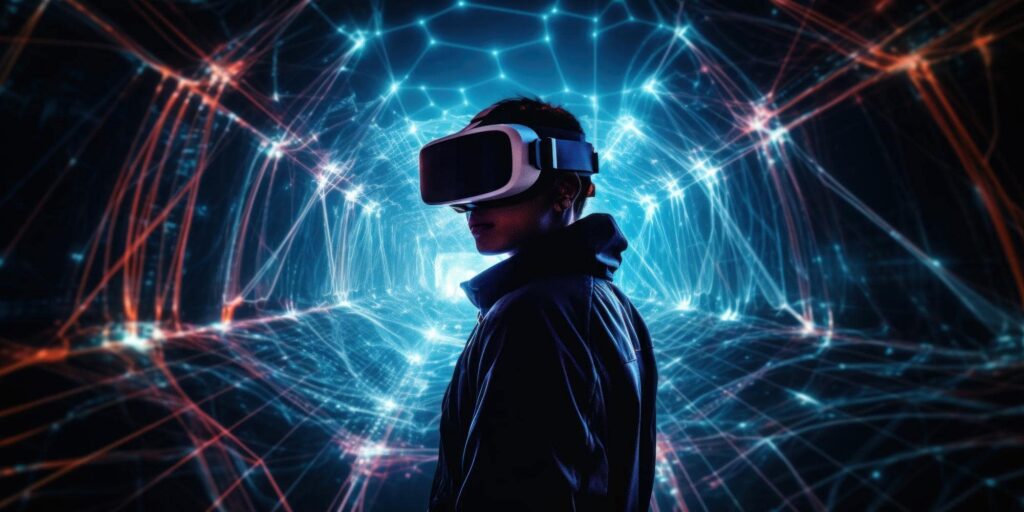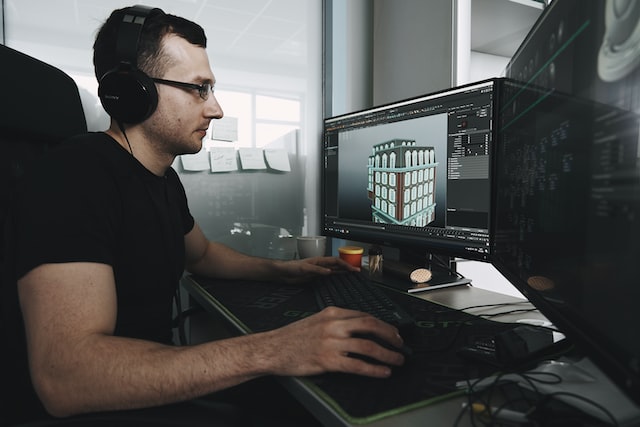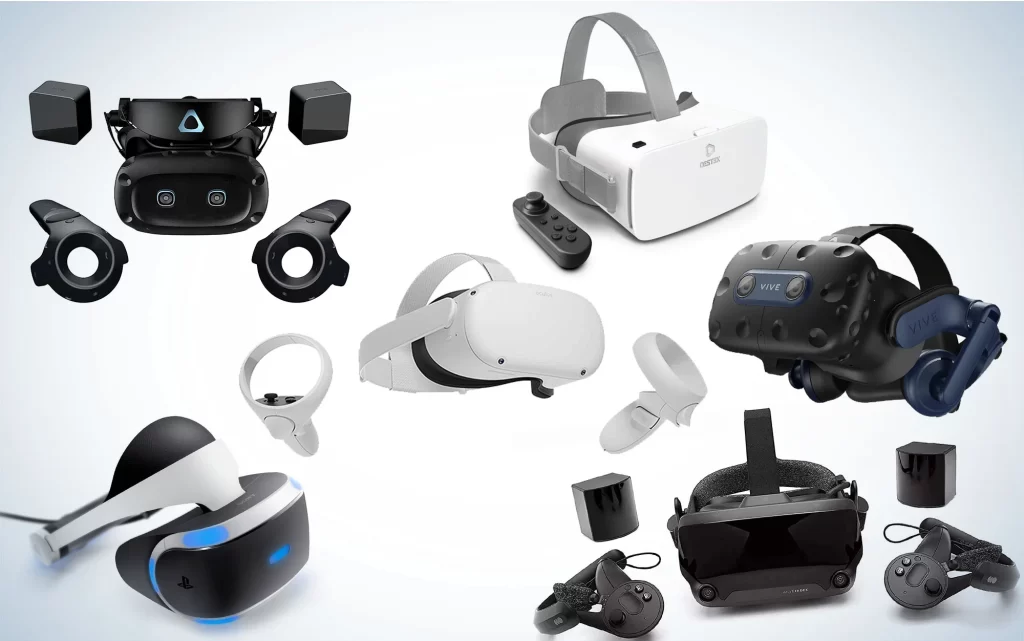Virtual reality has revolutionized the way we experience digital content. From immersive gaming environments to virtual tours of exotic locations, virtual reality has opened up new dimensions of entertainment, education, and exploration. But how to build a virtual reality world?
That’s the question we want to tackle in this article. We want to focus on presenting you with a guide on how to take the first steps toward building your own virtual reality world.
So let’s get right to it.

How to build a virtual reality world: defining your vision
The first step in how to build a virtual reality world is to establish a well-defined vision for your project. This visionary foundation serves as the compass that directs your project’s course, ensuring that you create an immersive and captivating experience.
Start by defining the primary purpose of your virtual reality world.
Is it primarily designed for gaming, where users can engage in various challenges and adventures?
Is it an educational platform aiming to impart knowledge and skills?
Perhaps it’s intended to provide users with a unique, artistic, or therapeutic experience.
Whatever it may be, understanding your central purpose will be the cornerstone upon which you build the entire project.
To bring your vision to life, you also need to consider the environment of your virtual reality world.
Do you envision a realistic replication of a physical space or a fantastical realm where the laws of physics and nature can be bent?
Your choice here will dictate the visual and auditory elements of your world, impacting everything from graphics to sound design.
Understanding your target audience is another pivotal step in tailoring your virtual reality world.
You need to create an experience that can be specific for children, adults, or any other specific group, identifying the interests, expectations, and familiarity with VR technology that your audience may have.

Choosing a development platform
Creating a virtual reality involves a plethora of development platforms and tools, each offering unique features and capabilities to cater to diverse project requirements and developers’ skill sets.
To learn how to build a virtual reality world, you should take a look at some popular software options.
Unity 3D
Unity 3D stands as a paramount choice in the realm of virtual reality development, and it boasts several key attributes that contribute to its popularity and success in this field.
First, it offers robust support for various VR platforms, making it a versatile solution for developers.
Whether you’re creating content for the Oculus Rift, HTC Vive, PlayStation VR, or other VR devices, Unity3D provides the necessary tools and plugins to streamline your development process.
One of Unity 3D’s standout features is its Asset Store, a treasure trove of pre-made VR assets and plugins.
This repository significantly accelerates development by providing ready-made solutions for common VR challenges. Whether you need VR locomotion systems, hand tracking, or immersive audio, chances are you’ll find the right asset in the store.
Its intuitive user interface caters to developers of all levels. Beginners appreciate its straightforward approach to scene creation, asset importing, and scripting.
At the same time, experienced developers benefit from the engine’s depth, allowing them to implement complex VR interactions and behaviors.
Unreal Engine
Unreal Engine, developed by Epic Games, stands as a prominent and highly respected game engine in the world of virtual reality and interactive 3D experiences.
Its reputation is rooted in several key features and capabilities that have propelled it to the forefront of VR development.
The engine is celebrated for its ability to deliver breathtakingly realistic graphics and immersive rendering capabilities. It leverages state-of-the-art rendering techniques and advanced lighting models to create visually stunning VR environments.
This capability makes Unreal Engine the go-to choice for developers aiming to create visually captivating and highly immersive VR experiences.
The Unreal Engine has an innovative visual scripting system known as Blueprints.
This user-friendly interface enables developers, including those without extensive coding skills, to create complex VR interactions and behaviors.
By connecting nodes in a visual graph, developers can design and prototype VR experiences with ease. This feature democratizes VR development, making it more accessible to a wider range of creators.
Despite being most known for its gaming application, its versatility extends beyond that. It is widely preferred for various applications, including architectural visualization, training simulations, and high-fidelity VR games.
Architectural firms utilize Unreal Engine to create interactive walkthroughs of buildings and spaces, providing clients with a realistic preview. Educational institutions and corporations employ it for training simulations, offering immersive learning experiences.
Blender
Blender is a remarkable and versatile software application that has gained widespread recognition in the world of 3D modeling and animation due to its increasing use in the movie industry.
This free and open-source platform has emerged as a preferred choice for professionals and hobbyists alike, particularly in the realm of virtual reality asset creation.
At its core, Blender is a robust set of modeling and sculpting tools. Whether you are an aspiring artist, a game developer, or a filmmaker, Blender provides a comprehensive toolkit for crafting intricate 3D objects, lifelike characters, and immersive environments.
Its sculpting capabilities enable users to manipulate digital clay, sculpting intricate details with precision, making it an ideal choice for creating realistic VR assets.
The software has introduced export options tailored to various VR platforms and formats. This integration allows artists and designers to easily export their 3D creations to popular VR platforms.

Acquiring the necessary hardware
A big part of how to build a virtual reality world is understanding that it comes with specific hardware requirements to bring your virtual vision to life.
We need to start with A VR headset, which is the cornerstone of any virtual reality experience. It serves as your window into the digital realm.
There are various options available on the market, so it’s crucial to select one that aligns with your chosen development platform and project goals.
Consider factors like display resolution, refresh rate, field of view, comfort, and tracking accuracy when choosing a headset. The choice of headset will significantly impact the quality of your VR world.
Next, you’ll need a high-performance computer.
VR applications are computationally demanding, as they need to render two high-resolution images in real time and maintain a consistently high frame rate to prevent motion sickness.
To ensure a smooth VR experience, your PC must meet or exceed the recommended specifications of your chosen VR headset.
Key hardware components for your computer include a powerful CPU (Central Processing Unit), a high-end GPU (Graphics Processing Unit), ample RAM (Random Access Memory), and fast storage (SSD recommended).
Then you need to consider motion controllers and other accessories, like VR-compatible gloves, haptic feedback devices, or body-tracking sensors.
These accessories can enable more immersive interactions and sensations within your virtual world, but they may also require additional development effort to integrate effectively.

The basics of 3D modeling and animation
Now for the hardest part: learning how to build a virtual reality world by learning 3D modeling.
3D modeling and animation are integral components of the virtual reality world. It enables the creation of lifelike objects, characters, and environments in virtual spaces, adding depth, realism, and interactivity to visual experiences.
It involves the crafting of three-dimensional objects and characters in a digital realm. This process allows artists and designers to replicate real-world elements or create entirely new ones with remarkable accuracy and detail.
As for the animation, it breathes life into static 3D models by giving them motion, personality, and interactivity.
Whether it’s a character walking, a car speeding down a virtual street, or objects reacting to user input, animation transforms static models into dynamic entities.
In VR, this dynamic nature is critical for engaging users and making them feel like active participants in the virtual environment.
The best way to start learning is by using virtual courses. Utilize online platforms like YouTube, Udemy, Coursera, and Khan Academy, which offer a plethora of tutorials and courses tailored to beginners.
Begin with simple projects, such as modeling basic objects or creating static scenes. Gradually advance to more complex tasks as you gain confidence.
Once you have a solid grasp of the basics, challenge yourself with character modeling, rigging, and animation exercises. This will expand your skill set and prepare you for more intricate projects.
Engaging with fellow enthusiasts and professionals by joining online developer communities can be another way to provide valuable support and opportunities for growth.
Start building your virtual reality world today
So hopefully now you understand a little bit more about how to build a virtual reality world, at least the very first steps you need to take.
Building a virtual reality world is a complex but rewarding endeavor. With a clear vision, the right tools, and a lot of creativity and patience, you can bring your virtual dreams to life.
Keep learning, testing, and refining your creation, and you’ll be well on your way to creating immersive VR experiences that captivate and delight users.
If you liked this article, there are many more in our blog, all related to the game development industry.

